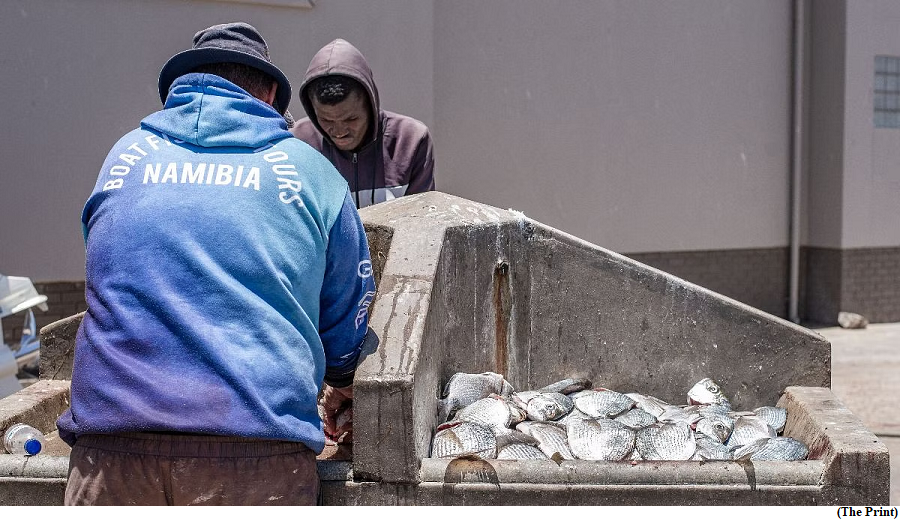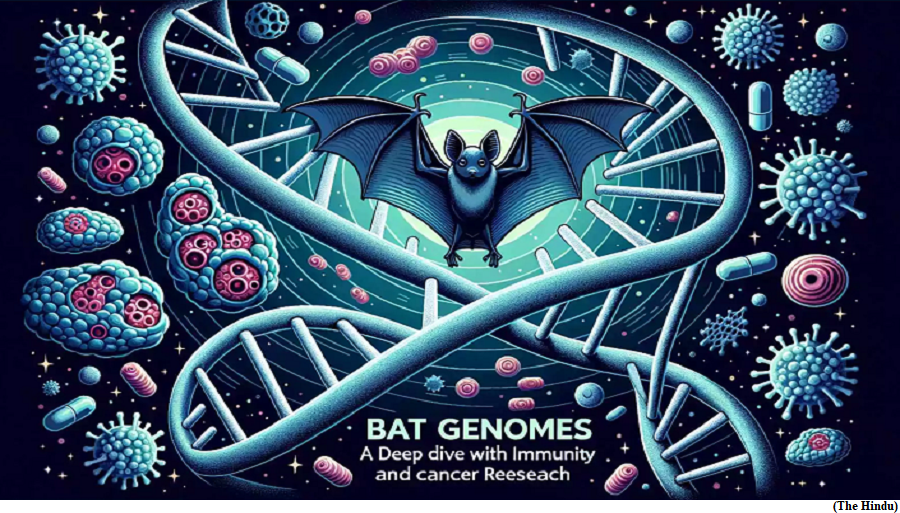Namibia is building a blue economy (GS Paper 3, Economy)

Why in news?
- The United Nations Food and Agriculture Organization (FAO) estimates that over one-third of seafood is lost or wasted while more than 92% of global fisheries are harvested at maximum yield or over-fished.
Potential of by-products of seafood processing:
- Losses occur at sea from primary processing of the catch and on land from processing in factories. Much of this can go toward production of fishmeal or fish oil.
- Around 25-35% of fishmeal production currently comes from by-products of seafood processing with demand increasing to meet the needs of the expanding aquaculture sector. Additionally, high value products can be developed from, for example, skins and livers.
- Food and job insecurity remain high concerns among many nations, particularly for coastal communities reliant on marine resources.
- The increased seafood processing would create more employment opportunities whilst supporting the scaling of local by-product innovations. Increasing the overall value of the fish may also allow for certain by-products to be sold to local communities.
Iceland Ocean Cluster:
- The Iceland Ocean Cluster, a company which facilitates networking opportunities for ocean related industries in Iceland and worldwide, has led the way in achieving increased utilization of their cod fishery. In doing so, they have created about 700 jobs and increased the market value of the fishery to around $500 million.
- New products and start-up companies in this movement have included wound dressings, nutraceuticals and a cola-style drink that has overtaken sales of premium cola brands in Iceland.
- Fish by-product innovation is gaining traction in many other coastal countries, such as in Kenya, where there is development of the fish leather industry.
Namibia towards a sustainable blue economy
- The Namibia Ocean Cluster is in the process of joining this network as the seafood industry collaboratively explores ways to optimize the utilization of post-harvest seafood losses and maximize the socioeconomic benefits derived from the country’s marine capture fisheries.
- Namibia faces significant challenges, with 22% of the population being food insecure and a 33% unemployment rate.
- The fishing sector plays a crucial role in the country’s economy, contributing 3.6% to its GDP, meaning it is well placed to play a positive role in addressing these systemic problems.
- It has strong enabling conditions to develop a collaborative approach as the fisheries are considered well-managed through Total Allowable Catch (TAC) systems and MSC certification for its primary fishery.
- Much like many commercial fisheries worldwide, large quantities of Namibian fisheries’ by-products are left at sea in the form of heads, internal organs, skins and frames.
- Research from 2018 revealed that around 33% seafood was lost, and approximately 71,000 tonnes removed off the boat, due to the heading and eviscerating process, a practice commonly employed by industrial fisheries.
Collaborative industry action:
- For nearly three years the Namibia fishing industry has worked with the World Economic Forum’s Ocean Action Agenda on a project, funded by the United Kingdom’s Blue Planet Fund, to build globally applicable models that can help reduce seafood loss and waste and maximise socio-economic value.
- Now, the executive representatives of the Namibia Ocean Cluster Working Group convened to commit to the coalition’s launch in January 2024. This Cluster is a multi-stakeholder organization that will provide a safe space to collaborate on operational and entrepreneurial solutions that address seafood loss and waste.
- The mission of the Cluster is to bring together the Namibian seafood sector and allied stakeholders, in a non-competitive, collaborative forum, which collectively believes in working towards maximizing viable utilization of all seafood post-harvest.
- This will lead to new product development, promotion of new economic models, research, methods, and markets.
Way Forward:
- The long-term impact of this industry shift will result in increased food production and nutrition security, higher value fish, increases in local employment and a more efficient use of marine resources, contributing to several of the Sustainable Development Goals.
How bat genomes provide insights into immunity and cancer
(GS Paper 3, Science and Technology)
Context:
- Bats have grabbed the headlines of late for the wrong reasons. Their notoriety stems from the fact that many deadly viruses use bats as a reservoir host, including coronaviruses, Nipah, Ebola, Marburg virus, and Hendra virus, among others.
- The COVID-19 pandemic also cast a bright spotlight on the habits of bats.
- Bats do host a wide variety of pathogens, including ones deadly to other mammals, but they themselves don’t get infected. Scientists have been curious about the source of this protection.

How bats are extraordinary organisms?
- They are the only mammals on the earth that can maintain sustained flight.
- They also have relatively long life-spans and are relatively more protected from a variety of diseases, including cancer.
- They also have a unique ability in echolocation, whereby they use sound to navigate and locate objects, freeing them from being constrained by the availability of light like humans are.
- By population, bats make up 20% of all mammals. There are more than 1,400 species of bats today around the world; more than 60 are endangered and 170-odd are classified as vulnerable.
- The bumblebee bat weighs only 2 grams whereas the flying foxes, which have a wingspan of 1.5 metres, weigh up to 1.6 kg.
- In all, bats play crucial roles in maintaining the ecological balance, and are essential for pollination, insect control, etc.
Bat genomes:
- Over the years, researchers have unearthed significant insights by sequencing the genomes of many bat species. Bats are also unique because they have a relatively small genome, around 2 billion bases.
- Earlier scientists compared the genomes of a fruit-eating and an insect-eating species and found that genes involved in metabolism and immune response had been positively selected. That is, these bats had evolved by improving these two biological domains.
- In the following decade, scientists sequenced a large number of bat genomes. The ambitious Bat1K global genome consortium to sequence all the 1,400 or so species’ genomes is also currently underway.
- By analysing bat genomes, scientists have found the natural selection of a protein called prestin, which is involved in echolocation (dolphins have the same protein).
Immune insights:
- Immunity-related genes have been one of the more well-studied gene classes in bats. The fraction of these genes is also unique in bats: some 2.7-3.5% of the bat genome versus roughly 7% of the human genome.
- Emerging evidence also suggests that a set of immune-related genes have been undergoing positive selection in bats, adapting them to control the spread of viruses while mitigating the antiviral inflammatory response.
- As a result, the bats are shielded from the effects of the clinical response of their bodies to these viruses.
Pro-inflammatory genes:
- The heightened pro-inflammatory activity is what makes these viruses deadly in humans.
- One of the first Bat1K genome consortium papers described six high-quality bat species genomes.
- It suggested that echolocation, loss of pro-inflammatory genes, and expansion of antiviral genes are ancestral traits of bats. This suggests that bats have molecular mechanisms that allow them to host a range of deadly viruses but evade clinical disease.
- The bats can harbour multiple viruses at the same time, i.e. in a state of co-infection, without themselves falling ill.
Long reads sequencing:
- Long-read sequencing technologies are those that can ‘read’ thousands to tens of thousands of bases of a genome at a time.
- With their advent, it has become possible today for scientists to quickly assemble the nearly complete whole-genomes of organisms.
- Another benefit to them is that they no longer had to use more complex, time-consuming, and expensive molecular technologies in the pursuit of building complete genomes.
Interferons (IFN):
- A recent report by researchers from the Cold Spring Harbor Laboratory, New York, used a long-read technology to sequence two bat genomes as well as compared the genomes of 15 species that were already available.
- They reported that subsets of genes involved in mounting an immune response which encode proteins called interferons (IFN) had contracted significantly. This in turn changed the relative proportions of two subsets, interferon-alpha (IFN-) and interferon-omega (IFN-), relative to each other.
- The researchers attributed bats’ immune properties to these changes. By shedding the genes for IFN-, bats can dampen the pro-inflammatory response against a number of viruses, thus protecting themselves from clinical disease.
Way Forward:
- With rapid deforestation, ecological degradation, and more and more unfavourable human-animal interactions, we should expect significantly enhanced outbreaks of zoonotic diseases in future.
- The Nipah outbreaks in Kerala over the last few years is an example, as are outbreaks of Marburg disease and the Ebola virus in some African countries.
Two experiments conducted by ISRO paved way for Gaganyaan test mission
(GS Paper 3, Science and Technology)
Why in news?
- There were two important forerunners to the success of the Test Vehicle Abort Mission (TV-D1) flight that the Indian Space Research Organisation (ISRO) conducted recently.
- During the test, an unmanned crew module was brought back safely to earth after launching it on a small rocket and simulating an emergency abort command.
- The test and its forerunners are the ISRO’s first major steps towards launching humans to orbit as part of its Gaganyaan mission.

SRE-1:
- The TV-D1 test was carried out smoothly, especially given that the ISRO had to overcome a glitch five seconds before lift-off, when the ground computer, called the Automatic Launch Sequence, halted the lift-off.
- The first forerunner to the TV-D1 mission was the ISRO’s Space Capsule Recovery Experiment (SRE-1). An orbiting satellite called the SRE was brought back to earth on January 22, 2007, after a Polar Satellite Launch Vehicle (PSLV) placed it in orbit on January 10.
- In a series of manoeuvres, the shuttlecock-shaped SRE came down from an altitude of 635 km to splash down into the Bay of Bengal, 140 km from Sriharikota, where the Coast Guard recovered it. India, thus, successfully brought back an orbiting satellite in its first attempt.
- The descent manoeuvres included sophisticated braking systems, deceleration techniques, and the deployment of parachutes. Overall, the SRE-1 mission showcased the ISRO’s mastery of re-entry technology.
- The SRE-1 was India’s first big step towards sending an Indian astronaut into space and bringing them back safely.
LVM-3:
- The second forerunner to the TV-D1 mission happened on December 18, 2014, when the Launch Vehicle Mark 3 (LVM-3) placed the 3.75-tonne unmanned crew module in a sub-orbital altitude of 126 km, and left it to descend.
- The module knifed through the earth’s atmosphere and also survived re-entry. Its parachutes deployed and soon it was bobbing in the Bay of Bengal, about 700 km from Port Blair.
- This test, called Crew Module Atmospheric Re-entry Experiment (CARE), marked India’s second step towards sending its astronauts into space and getting them back.
Outcome:
- While the SRE weighed about 555 kg, the unmanned crew module in CARE weighed nearly seven times as much. In TV-D1, the module weighed 200 kg more, a full four tonnes.
- The TV-D1 also had three other highlights. They were
- a standalone liquid booster rocket launching for the first time from Indian soil;
- the successful performance of the Crew Escape System that pulled the crew module away from the launch vehicle; and
- the crew module reorienting itself before landing in the Bay.




